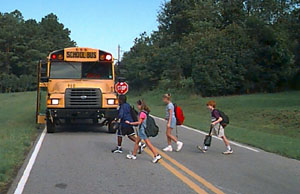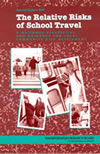

HSRC News Briefs
HSRC researchers mentor UNC planning students
University of North Carolina at Chapel Hill graduate students from the Department of City and Regional Planning received guidance and expertise from several HSRC researchers during the Fall 2005 semester. The Center took on the pedestrian planning class, which included topics such as conforming to Americans with Disabilities Act guidelines and engineering improvements.
Robertson shares safety research with school transportation officials
Dr. Doug Robertson, HSRC’s director, served as the luncheon speaker for the 2005 North Carolina School Bus Safety Conference.
Speaking to a group of transportation directors, assistant superintendents and others responsible for student safety, Robertson presented research from The Relative Risks of School Travel: A National Perspective and Guidance for Local Community Assessment.
“Children are at far more risk traveling to and from school in private passenger vehicles — especially if a teen-age driver is involved — than in school buses,” said Robertson.

According to the study, an average of 800 children died and 152,000 children were injured yearly during school travel between 1991and 1999. Passenger vehicle crashes were responsible for 75 percent of those deaths and 84 percent of the injuries, and bicycle and pedestrian crashes represented 22 percent of deaths and 11percent of injuries. School bus travel was the safest form of travel studied, with crashes involving school buses accounting for only 2 percent of deaths and 4 percent of injuries.
The most risky form of school travel is in cars driven by teenagers. While cars with teen drivers accounted for only 14 percent of student school trips, teens were at the wheel when over half of the injuries and fatalities occurred. Fourteen and fifteen year-olds were most likely to be hurt or killed as passengers in cars operated by a teenage driver.
The report was produced by a committee of school transportation experts convened by the National Academies' Transportation Research Board and was sponsored by the National Highway Traffic Safety Administration. Robertson served as chair of this committee.
NC ECHS chat with teens on distracted driving
It is estimated that between 1.5 million and 3 million crashes occur annually as a result of distracted drivers, and National Highway Traffic Safety Administration data shows that drivers aged 16 to 20 are four times as like to be involved in a distraction related crash.
To obtain a better understanding of the North Carolina teen’s perspective on distracted driving, the North Carolina Executive Committee for Highway Safety (ECHS) will conduct a series of discussions with teens from across the state. As a part of the Keeping Drivers Alert working group, these discussions will serve as a springboard for an integrated outreach campaign to reduce fatalities and injuries caused by distracted driving. HSRC Director Doug Robertson, Associate Director for Social and Behavior Research Jane Stutts and Public Relations Manager Katy Jones serve on this working group.
The ECHS “strives to identify, prioritize, promote and support all emphasis areas in the American Association of State Highway and Transportation Officials (ASSHTO) Strategic Highway Safety Plan as well as emphasis areas not included in the AASHTO Plan for the coordinated North Carolina highway safety effort to save lives and reduce injuries.”
The University of North Carolina Highway Safety Research Center
730 Martin Luther King Jr. Blvd, Suite 300 | Campus Box 3430 | Chapel Hill, NC 27599-3430
Phone: 919.962.2203 | Fax: 919.962.8710
http://www.hsrc.unc.edu
